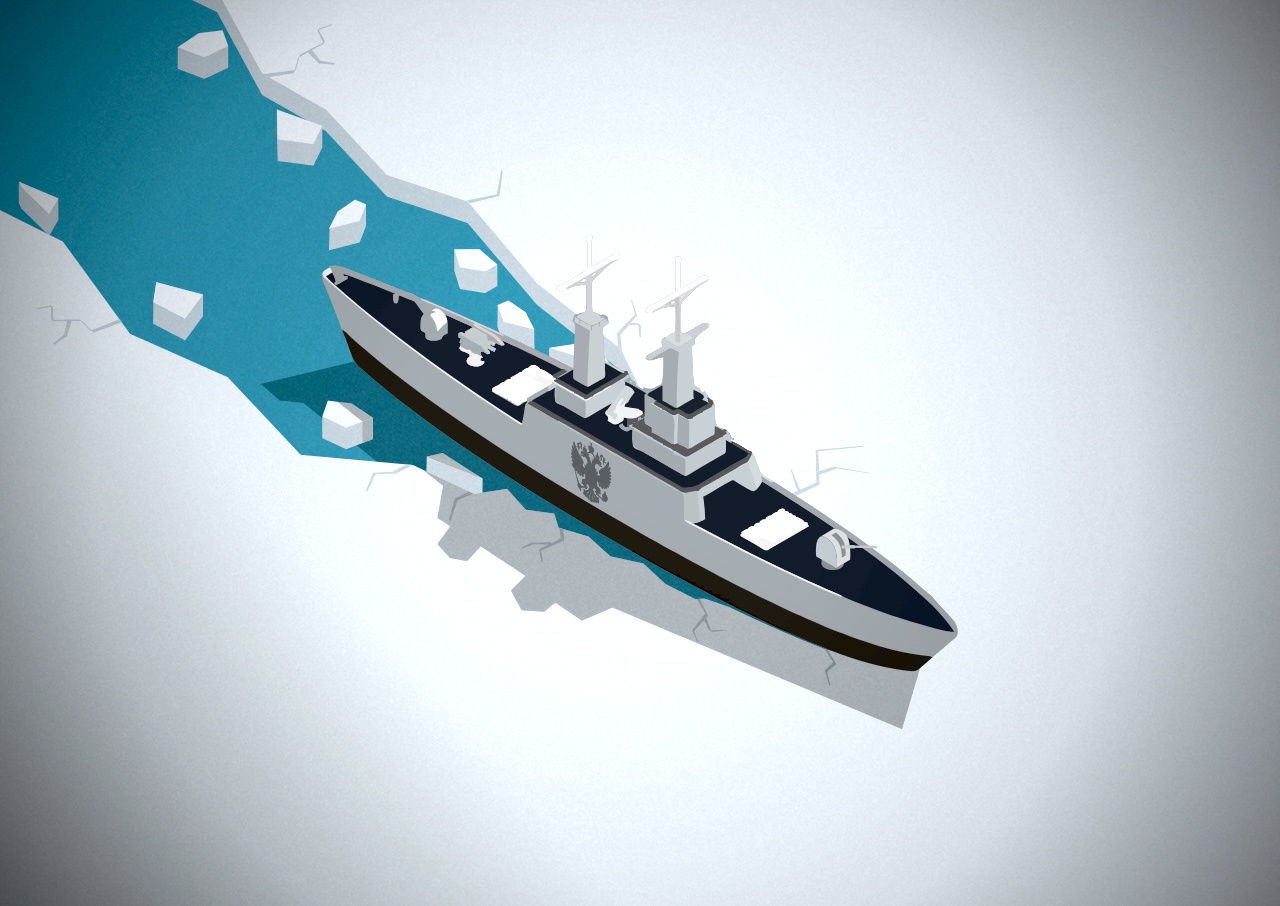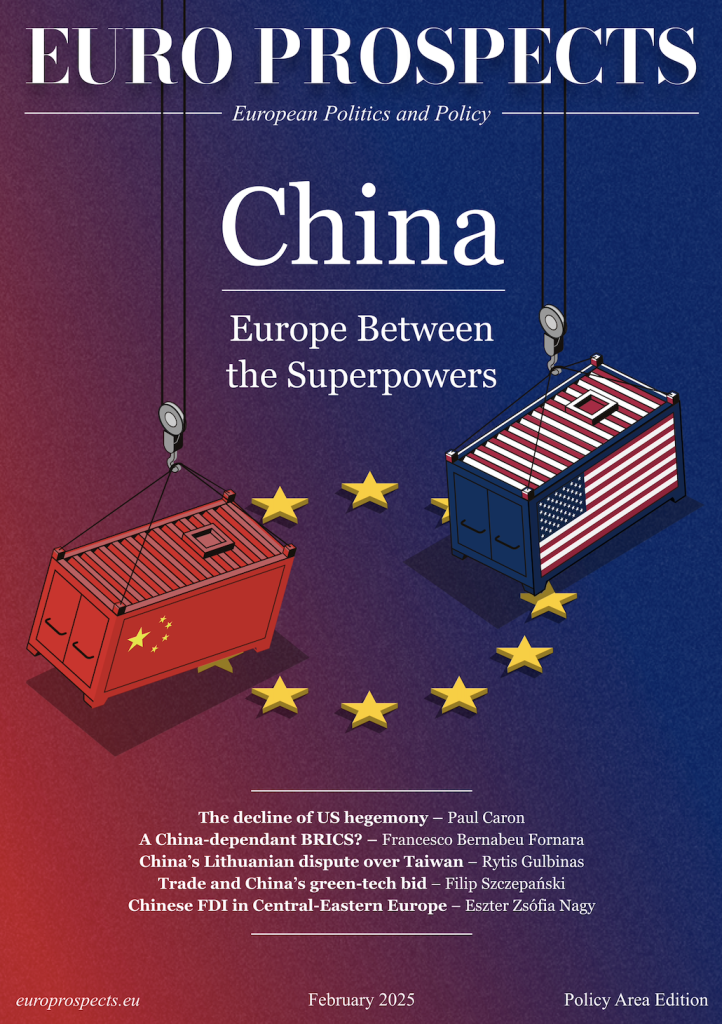
12 min read — Security | Arctic | Geopolitics | EU
Melting Arctic Ice and Russian Expansionism in the North

Arctic Transformation
The Arctic region has undergone a major change, on which global warming impacts much more rapidly than on other environments. It is estimated that the Arctic ice may be warming three or four times faster than other parts of the world. According to the National Snow and Ice Data Center, Arctic Sea ice reached its annual maximum on March 22, 2025, the lowest maximum sea level in the past 47 years of recorded data. Often called the Earth’s refrigerator, due to its ability to cool down warm weather patterns” plays an important part in our planet’s climate.
Another aspect of Arctic change is the accelerated loss of multiyear ice sheets, which has significantly lessened the amount of ice that vessels have to navigate through. Therefore, arctic shipping becomes more profitable, which not only creates a ripe field for tensions between states, but also heightens the risk for environmental damage.
Opportunities created by Arctic Transformation
The Arctic’s melting ice endangers biodiversity and global climate stability, but simultaneously, creates “windows of opportunities” for political actors to pursue their commercial and industrial interests.
Despite environmental issues, melting Arctic ice will increase accessibility and navigability of the Arctic for commercial ships. Melting Arctic ice primarily means the lower thickness of Arctic ice and consequently longer periods for ice-free naval routes. By all means, expanded shipping in the Arctic would require adaptation to extreme weather conditions and emergency management, but the expected shortened routes and cheaper shipping is a great incentive for many commercial and political reasons.
Most importantly, Arctic naval routes impressively shorten commercial shipping times and costs between Europe and Asia. This permanent and inconvertible environmental damage is seen as a “window of opportunity” which can strongly influence geopolitics and global power dynamics.
One of the main commercial and industrial domains which is expected to further grow and develop as Arctic ice is increasingly melting, is the shipping industry. As studies show, the Arctic naval routes can be 30% or even 50% shorter than naval shipping routes of the Suez Canal or Panama Canal and this difference can lower the shipping time by approximately 14 to 20 days. This difference in the length of naval routes lowers shipping costs significantly, meaning the huge increase of net profit margins in the shipping industry and its related fields. Arctic sea routes will connect Atlantic and Pacific voyages, enabling a huge economic boom for regional players.
Russia’s Posture and Geopolitical Tensions of the Arctic
There are three main sea routes in the Arctic – the Northwest passage starting from the waters between Greenland and Canada; Northeast passage along the borders of Scandinavia and Russia; and Transpolar Sea route which is the least used route because of harsh climatic conditions.
The Northern Sea Route (NSR) within the Russian exclusive economic zone goes along the Northeast passage from the Barents Sea to the Bering Strait. Also, there is a seasonal Arctic Sea Bridge which connects Russia’s port of Murmansk to Canada. The navigability of these routes are still largely dependent on seasons and ice thickness.
The Arctic is rich in natural resources, particularly in oil and natural gas resources, which still are the dominant industries for the international economy. According to the assessment by the U.S. Geological Survey, the Arctic region holds 13% of the world’s undiscovered oil resources and 30% of the world’s undiscovered natural gas resources.
Russia’s increasing interest in the Arctic region is obvious by analyzing the expanding use of the Northern Sea Route (NSR), which is administered by the Russian Federation. The scale of NSR’s use increased especially after western sanctions were imposed against Russian energy resources and shipping industry. Oil and gas industry provides nearly 20% of the country’s GDP, therefore NSR became a crucial alternative route for Russia following their full-scale invasion of Ukraine.
As outlined in Russia’s Arctic Strategy to 2035 adopted in 2020, Russia’s Arctic zone has 80 percent of the natural gas resources and seventeen percent of crude oil resources of the whole country, which is more than sufficient for domestic use. Since 2005, Russia has also been developing Liquified Natural Gas (LNG) plants, most importantly the LNG plant on Yamal peninsula administered by Novatek, which plans to increase its LNG production in the next 15 years.
The Southern naval route from Russia’s Murmansk port to China’s Rizhao port, which takes about 45 days, goes through the Seez Canal. Meanwhile, the Northern route between Murmansk and Rizhao takes only 35 days. According to Viktor Katona, a crude analyst from Kpler, by taking the Northern route, Russia can save approximately half a million dollars per voyage solely on fuel expenses.
Although NSR’s importance has significantly increased after the imposition of western sanctions, Russia has utilized the NSR route for several years. The annual deadweight tonnage (DWT – measurement of shipping contents) has increased from 2013 to 2018, signaling Russia’s intentions of rapidly expanding its economic interests. After 2022, Russian exports in Asia, particularly to China and India, have been instrumental in keeping Russia’s energy sector afloat.
Further, in September 2023 Russia authorized the use of thin-hulled vessels – oil and LNG tankers in the NSR route during the summer and autumn seasons, which possess a disastrous threat to the environment because of potential oil spills. Two of these vessels have successfully sailed from Russia’s northern ports to China, covering over 5600 km – despite not being built for the Arctic’s demanding conditions.
According to Russia’s Arctic Strategy, by 2035 new seaports, railroad systems and related infrastructure are to be developed. Additionally, Russia’s larger vessels need assistance from tugboats to successfully navigate the NSR. In essence, Russia monopolizes the icebreaker industry. Russia also plans to develop an Arctic telecommunications system to support their rapidly growing fleet; its newests addition – nuclear-driven icebreakers are operated by Rosatom.
In Russia’s Arctic Strategy, high living standards and prosperity for the people living in the Russian arctic is highlighted as a strategic goal. Given Russia’s history of invasing its neighbors, particularly Georgia in 2008 and Ukraine in 2014, which forces the allocation of important resources, will make achieving this goal difficult.
While the Arctic hasn’t seen conflict since WWII, signs of rising tensions in the region are starting to appear. Svalbard island between the Greenland Sea and Barents Sea in the Arctic is one of the geopolitical issues. Russians and Norwegians have been residing on this islands for a long time, but there has been diplomatic tension over the establishing new fishing zones. Russia’s foreign ministry released a statement in February 2020 regarding Norway’s activities on Svalbard, which Russia sees as overshadowing rights to local fishing and natural resources.
NATO’s recent addition of Sweden and Finland has raised concerns about future geopolitical tensions in the Arctic. Finland and Sweden’s accession in NATO has fueled Russia’s fears of encirclement by NATO and perceived and presenting every action as a hostile act against Russia and its people in the Arctic.
Norway’s posturing regarding Russia’s passive aggressive maneuvers has not been too bold, but from July 2024, Norwegian Parliament announced that they would start limiting and sometimes prohibiting sales of properties in Svalbard Island, preventing foreign direct investments linked to Russia.
Also, it is significant that the Russo-Ukrainian war has reached the Arctic zone too, when Ukrainian forces attacked with drones on Olenya air base in the Russian Arctic. Also, we can observe low intensity activities by Russian forces in the Arctic, even in peacetime, which can be understood as aggressive signaling actions. These dynamics in the transatlantic geopolitics on the one hand, and impressive commercial and political opportunities for Arctic states on the other hand, show that geopolitical tensions are more likely to increase in this region and may resemble anachronistic conflicts of past centuries characterized by the incentive to gain access to new routes, opportunities, and resources.
Melting of Arctic ice not only transforms the global environment, but also greatly affects geopolitical dynamics. In recent years Russia has increased and consolidated its aggressive posture in the Arctic. For the Kremlin, the Arctic represents a chance to balance Western economic pressure, and strengthen its military, economic, and political positions.
Disclaimer: While Euro Prospects encourages open and free discourse, the opinions expressed in this article are those of the author(s) and do not necessarily reflect the official policy or views of Euro Prospects or its editorial board.
Write and publish your own article on Euro Prospects
Subscribe to our newsletter – stay informed when we publish articles on pressing European affairs.

